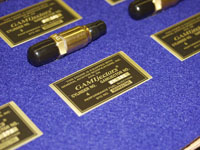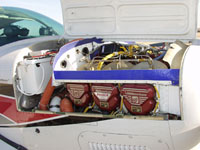Make the Most of Your Engine's Performance
Reprint from Flying Information, Volume II- 2000: Make the Most of Your Engine's Performance
by Ron Sanow
Power, performance, reliability. These are the standards required of every engine. We operate in many different climates and environments. We expect peak performance and power on every take off.
That's why I like some of the newer systems and products available to help monitor the engine's health. Improvements like GAMI Injectors improve the engine's performance by balancing the fuel/air mixture ratio available to every cylinder.
JPI and Insight are two manufacturers of graphic engine monitors that provide the ability to simultaneously monitor all cylinder head temperatures and exhaust gas temperatures. This real time information requires a planned response.
Increasing the aircraft climb airspeed in hot environmental conditions will help keep the engine cool. Use a selfimposed cylinder head temperature red line of 400 degrees Fahrenheit or 200 degrees Celsius. (Sometimes this may be difficult to achieve in turbocharged engines.) Increasing climb airspeeds, as well as taking action to achieve higher cooling fuel flows at high power settings, will help. Operating engines for long periods of time (extended climbs) at high temp will reduce cylinder life.
It is also important to have the fuel flows adjusted to the red line for take off. This will provide adequate fuel for engine cooling for take off and the initial part of the climb. A transition to a higher cruise climb airspeed can then be achieved to provide increased cooling airflow. Leaving the throttle at full for normally aspirated (nonturbo'ed) engines will help provide increased fuel flow for initial climbs. This enriches the engine at high power. Engines manufactured in the last 10 years will tend to run a bit hotter than the engines of the 80's. The cylinder heads are a bit more massive and retain more heat.
GAMI injectors are a sound investment. It's amazing the difference just at idle. Overall the engine sounds better and runs more smoothly. The most notable difference is to look at temp differences on a graphic engine monitor with the GAMI's compared to stock injectors and you will wonder why Continental Motors did not figure this balancing trick out years ago. The engine is smoother in cruise and the temps are balanced.
Keeping the temps down and balancing the cylinder head temps are as important as keeping the oil clean. I review over 200 oil sample reports every year and I would have to recommend that operators change oil at 25 hour intervals. We have clients that change their oil at 25 hours and others who prefer to wait to change filters and oil at 50 hours. When they do only a 50 hour service, the metals in the oil and the wear trends are much higher. We have a few samples that are pulled at 60-70 hours and the metal content in the samples are significantly higher.
Most oil companies recommend replacing oil at no more than 50 hour or 4 month intervals and 25 hours for engines that have oil screens. I have observed through compression checks and have the oil changed at 25 hour intervals have less wear and maintain compressions at higher levels.
Remember, some oil consumption is good. It indicates that your oil is providing an appropriate seal at the compression ring. Low oil consumption may indicate that sealing is inadequate, leading to blow by, power loss and increased cylinder bore wear. So what is the right amount? I would like to see about 0.08 quarts per hour. Doing regular oil analysis is an inexpensive method to monitor your engine wear. As an aircraft engine oil does its job, its composition changes. It accumulates contaminants from combustion, dirt, corrosion particles and metallic wear particles that can impair lubrication and accelerate wear. Analyzing the content of this used oil can help discover engine problems before they become expensive.
Since about 1993 we have seen more cylinder wear and lower compressions. When we borescope the cylinders with low compressions (60 lbs or below), we normally find fairly heavy cylinder wear, smooth walls with little to no crosshatch remaining. Cylinders in the low 50's are still considered airworthy by Continental Motors (according to their Service Bulletin 84-15).
The best simple mechanical defense I can recommend to keep an engine in good health with good compression, power and performance is to maintain good airflow baffling. Those mysterious black rubber or blue Teflon strips inside your engine cowling are essential for good cooling health. If they are worn or misaligned, the balance of cooling airflow across the cylinders can be disturbed, resulting in increased cylinder head temps. Once again, keep the engine cool in climb especially long extended climbs, and keep the oil clean.
Take advantage of all of today's systems that are available to monitor the health of your engine. Your life and your wallet depend on it.


